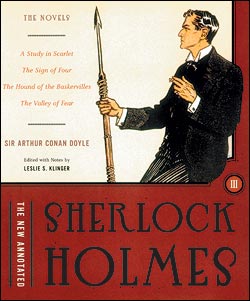Sir Arthur Conan Doyle notoriously got so fed up with his creation Sherlock Holmes that he killed the Great Detective in a story decisively titled “The Final Problem.” How humiliating it must have been for the proud author of the pioneering sci-fi Professor Challenger stories, the meticulously researched historical novel The White Company, the medial reminiscences of Round the Red Lamp, to have to revive the supercilious Sherlock for another two novels and 30 stories, while the far more promising Professor Moriarty remained drowned at the bottom of the Reichenbach Fall.
But Holmes refused to die in 1896, and he refuses to die today. Last year, Norton issued his annotated short stories in a 10-pound, two-volume slipcased edition, and this holiday season brings the companion collection of the four Holmes novels. The hope is obviously that, having recovered from last year’s sticker shock, the same customers will dutifully line up again. This may not be a sound hope, because Sherlockians have always been somewhat divided in their enthusiasms.
Some love the breadth of narrative of the full-dress sagas that began the canon: the brilliantly titled A Study in Scarlet, which introduces Holmes, Watson, and their bachelor ménage at 221B Baker St.; the Indian revenge romance The Sign of Four; followed by the most famous Holmes romance of all, The Hound of the Baskervilles; and the rather tired anarchists-and-Pinkertons shoot-’em-up The Valley of Fear. Others, myself among them, find the novels strained and (Hound apart) clumsily structured and devoid of suspense. For us, a single tale like “The Musgrave Ritual” or “The Man With the Twisted Lip” contains more ingenuity, more atmosphere, and more sheer satisfaction than all four novels put together.
Still, the New Annotated edition of the novels has its solid merits. The sepia-toned annotations which flank most pages are sometimes excessive (too much about Holmes’ cocaine habit) and sometime finicky (“The ‘perhaps’ seems to indicate that Holmes had not received Watson’s previous letter.” Really; and . . . ?). But more than 100 years have passed since Conan Doyle wrote these tales, and the life, London, and the world have changed enough that it’s nice to be alerted that in his day “little Russia” meant Ukraine, not Belarus, that the Lyceum Theatre was the home of high-toned melodrama, and that a baronet is neither a small baron nor of noble birth. And series editor Leslie Klinger has gleaned a wonderful array of illustrations, many drawn from the publications that first serialized the novels in England, in America, and on the Continent, others completely irrelevant to the tale in question but evocative of the blessed era before photographic illustration put a thousand graphic artists out to pasture.








